Social Innovation: Examining Pay Equity in Various Industries
VerifiedAdded on 2021/04/17
|11
|2928
|50
Essay
AI Summary
This essay delves into the multifaceted issue of pay equity, examining the concept of equal pay for equal work and its implementation across various sectors. It begins by defining the equal pay act, outlining key considerations such as skills, effort, working conditions, and establishment. The essay then contrasts the approaches of Iceland and the US, highlighting Iceland's stricter enforcement and the US's more nuanced legal framework. Furthermore, it explores the pay gap in Hollywood and sports, analyzing the reasons behind these disparities, including unconscious biases and societal norms. The essay also investigates the factors contributing to the gender pay gap, addressing employer perceptions and societal expectations. Through this comprehensive analysis, the essay aims to provide a clear understanding of the challenges and complexities surrounding pay equity and its implications for social innovation.
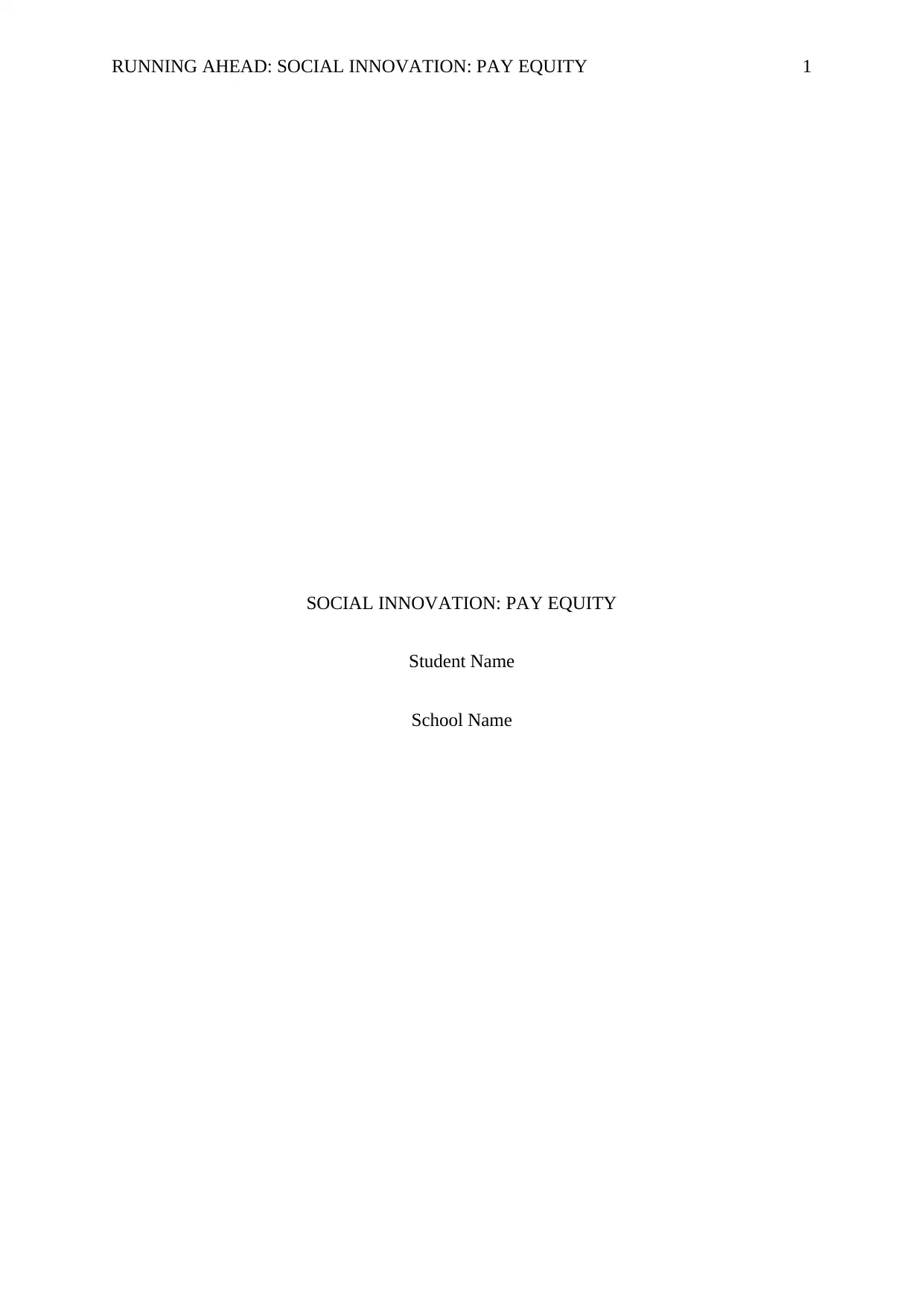
RUNNING AHEAD: SOCIAL INNOVATION: PAY EQUITY 1
SOCIAL INNOVATION: PAY EQUITY
Student Name
School Name
SOCIAL INNOVATION: PAY EQUITY
Student Name
School Name
Paraphrase This Document
Need a fresh take? Get an instant paraphrase of this document with our AI Paraphraser
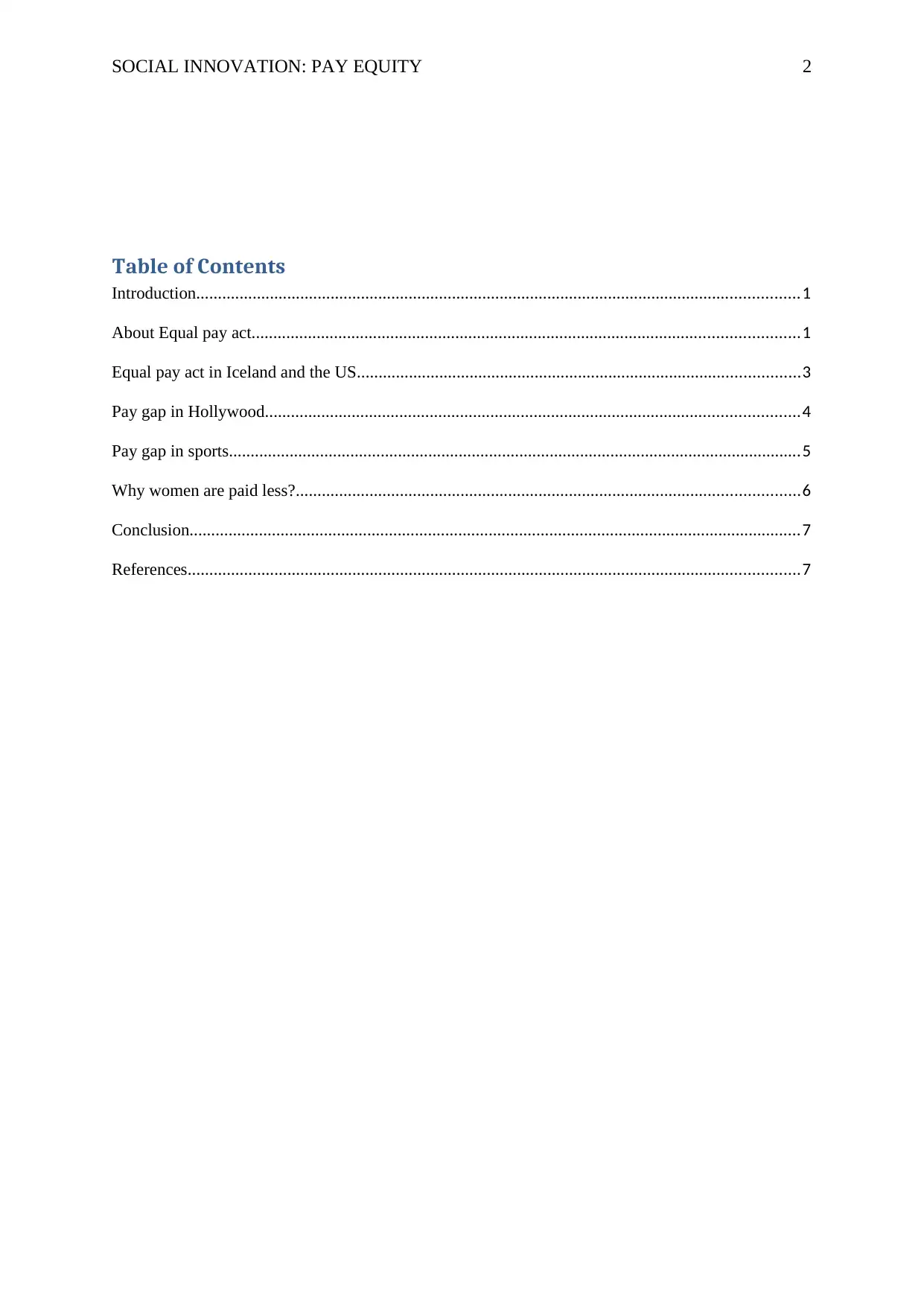
SOCIAL INNOVATION: PAY EQUITY 2
Table of Contents
Introduction...........................................................................................................................................1
About Equal pay act..............................................................................................................................1
Equal pay act in Iceland and the US......................................................................................................3
Pay gap in Hollywood...........................................................................................................................4
Pay gap in sports....................................................................................................................................5
Why women are paid less?....................................................................................................................6
Conclusion.............................................................................................................................................7
References.............................................................................................................................................7
Table of Contents
Introduction...........................................................................................................................................1
About Equal pay act..............................................................................................................................1
Equal pay act in Iceland and the US......................................................................................................3
Pay gap in Hollywood...........................................................................................................................4
Pay gap in sports....................................................................................................................................5
Why women are paid less?....................................................................................................................6
Conclusion.............................................................................................................................................7
References.............................................................................................................................................7
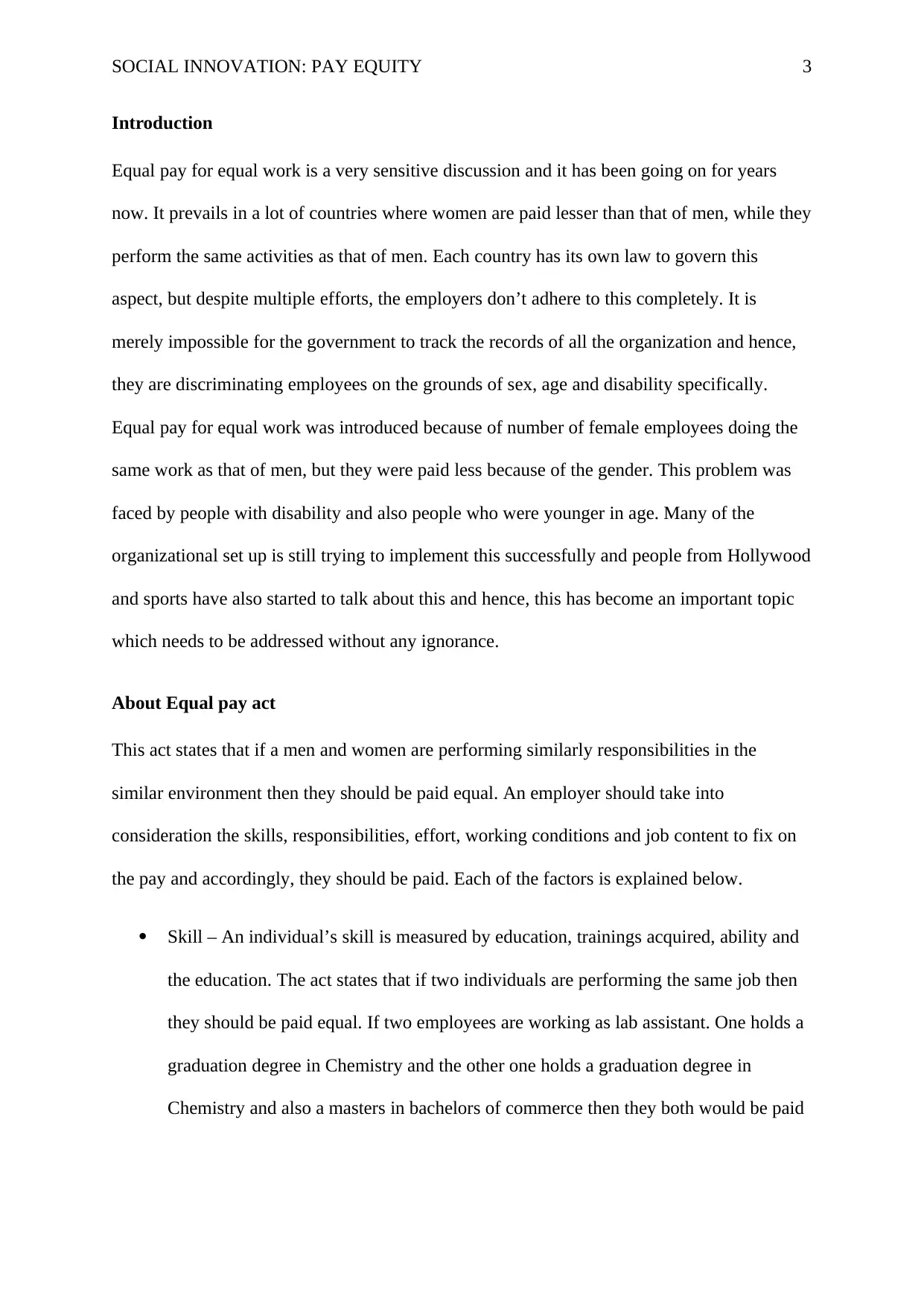
SOCIAL INNOVATION: PAY EQUITY 3
Introduction
Equal pay for equal work is a very sensitive discussion and it has been going on for years
now. It prevails in a lot of countries where women are paid lesser than that of men, while they
perform the same activities as that of men. Each country has its own law to govern this
aspect, but despite multiple efforts, the employers don’t adhere to this completely. It is
merely impossible for the government to track the records of all the organization and hence,
they are discriminating employees on the grounds of sex, age and disability specifically.
Equal pay for equal work was introduced because of number of female employees doing the
same work as that of men, but they were paid less because of the gender. This problem was
faced by people with disability and also people who were younger in age. Many of the
organizational set up is still trying to implement this successfully and people from Hollywood
and sports have also started to talk about this and hence, this has become an important topic
which needs to be addressed without any ignorance.
About Equal pay act
This act states that if a men and women are performing similarly responsibilities in the
similar environment then they should be paid equal. An employer should take into
consideration the skills, responsibilities, effort, working conditions and job content to fix on
the pay and accordingly, they should be paid. Each of the factors is explained below.
Skill – An individual’s skill is measured by education, trainings acquired, ability and
the education. The act states that if two individuals are performing the same job then
they should be paid equal. If two employees are working as lab assistant. One holds a
graduation degree in Chemistry and the other one holds a graduation degree in
Chemistry and also a masters in bachelors of commerce then they both would be paid
Introduction
Equal pay for equal work is a very sensitive discussion and it has been going on for years
now. It prevails in a lot of countries where women are paid lesser than that of men, while they
perform the same activities as that of men. Each country has its own law to govern this
aspect, but despite multiple efforts, the employers don’t adhere to this completely. It is
merely impossible for the government to track the records of all the organization and hence,
they are discriminating employees on the grounds of sex, age and disability specifically.
Equal pay for equal work was introduced because of number of female employees doing the
same work as that of men, but they were paid less because of the gender. This problem was
faced by people with disability and also people who were younger in age. Many of the
organizational set up is still trying to implement this successfully and people from Hollywood
and sports have also started to talk about this and hence, this has become an important topic
which needs to be addressed without any ignorance.
About Equal pay act
This act states that if a men and women are performing similarly responsibilities in the
similar environment then they should be paid equal. An employer should take into
consideration the skills, responsibilities, effort, working conditions and job content to fix on
the pay and accordingly, they should be paid. Each of the factors is explained below.
Skill – An individual’s skill is measured by education, trainings acquired, ability and
the education. The act states that if two individuals are performing the same job then
they should be paid equal. If two employees are working as lab assistant. One holds a
graduation degree in Chemistry and the other one holds a graduation degree in
Chemistry and also a masters in bachelors of commerce then they both would be paid
You're viewing a preview
Unlock full access by subscribing today!
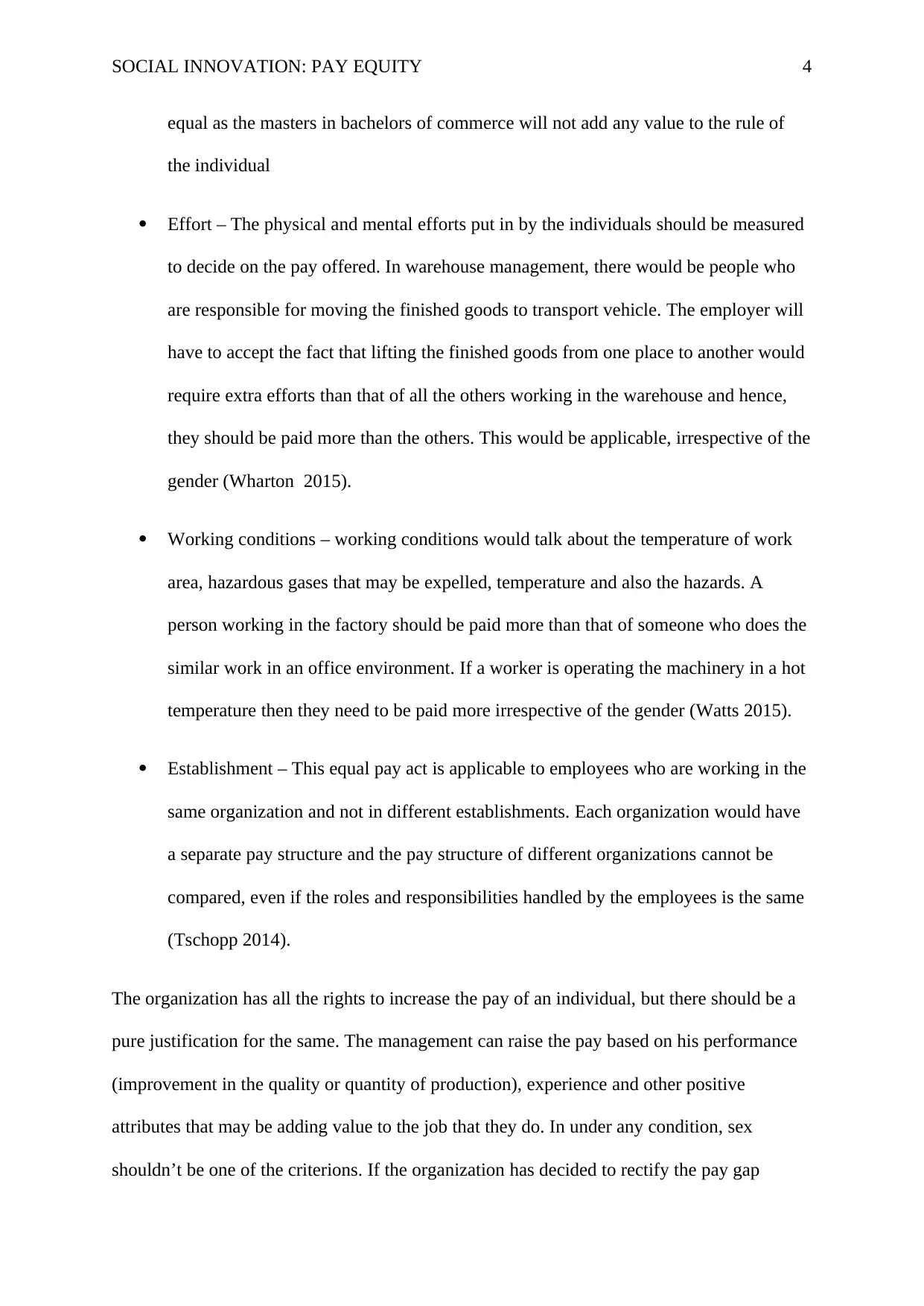
SOCIAL INNOVATION: PAY EQUITY 4
equal as the masters in bachelors of commerce will not add any value to the rule of
the individual
Effort – The physical and mental efforts put in by the individuals should be measured
to decide on the pay offered. In warehouse management, there would be people who
are responsible for moving the finished goods to transport vehicle. The employer will
have to accept the fact that lifting the finished goods from one place to another would
require extra efforts than that of all the others working in the warehouse and hence,
they should be paid more than the others. This would be applicable, irrespective of the
gender (Wharton 2015).
Working conditions – working conditions would talk about the temperature of work
area, hazardous gases that may be expelled, temperature and also the hazards. A
person working in the factory should be paid more than that of someone who does the
similar work in an office environment. If a worker is operating the machinery in a hot
temperature then they need to be paid more irrespective of the gender (Watts 2015).
Establishment – This equal pay act is applicable to employees who are working in the
same organization and not in different establishments. Each organization would have
a separate pay structure and the pay structure of different organizations cannot be
compared, even if the roles and responsibilities handled by the employees is the same
(Tschopp 2014).
The organization has all the rights to increase the pay of an individual, but there should be a
pure justification for the same. The management can raise the pay based on his performance
(improvement in the quality or quantity of production), experience and other positive
attributes that may be adding value to the job that they do. In under any condition, sex
shouldn’t be one of the criterions. If the organization has decided to rectify the pay gap
equal as the masters in bachelors of commerce will not add any value to the rule of
the individual
Effort – The physical and mental efforts put in by the individuals should be measured
to decide on the pay offered. In warehouse management, there would be people who
are responsible for moving the finished goods to transport vehicle. The employer will
have to accept the fact that lifting the finished goods from one place to another would
require extra efforts than that of all the others working in the warehouse and hence,
they should be paid more than the others. This would be applicable, irrespective of the
gender (Wharton 2015).
Working conditions – working conditions would talk about the temperature of work
area, hazardous gases that may be expelled, temperature and also the hazards. A
person working in the factory should be paid more than that of someone who does the
similar work in an office environment. If a worker is operating the machinery in a hot
temperature then they need to be paid more irrespective of the gender (Watts 2015).
Establishment – This equal pay act is applicable to employees who are working in the
same organization and not in different establishments. Each organization would have
a separate pay structure and the pay structure of different organizations cannot be
compared, even if the roles and responsibilities handled by the employees is the same
(Tschopp 2014).
The organization has all the rights to increase the pay of an individual, but there should be a
pure justification for the same. The management can raise the pay based on his performance
(improvement in the quality or quantity of production), experience and other positive
attributes that may be adding value to the job that they do. In under any condition, sex
shouldn’t be one of the criterions. If the organization has decided to rectify the pay gap
Paraphrase This Document
Need a fresh take? Get an instant paraphrase of this document with our AI Paraphraser
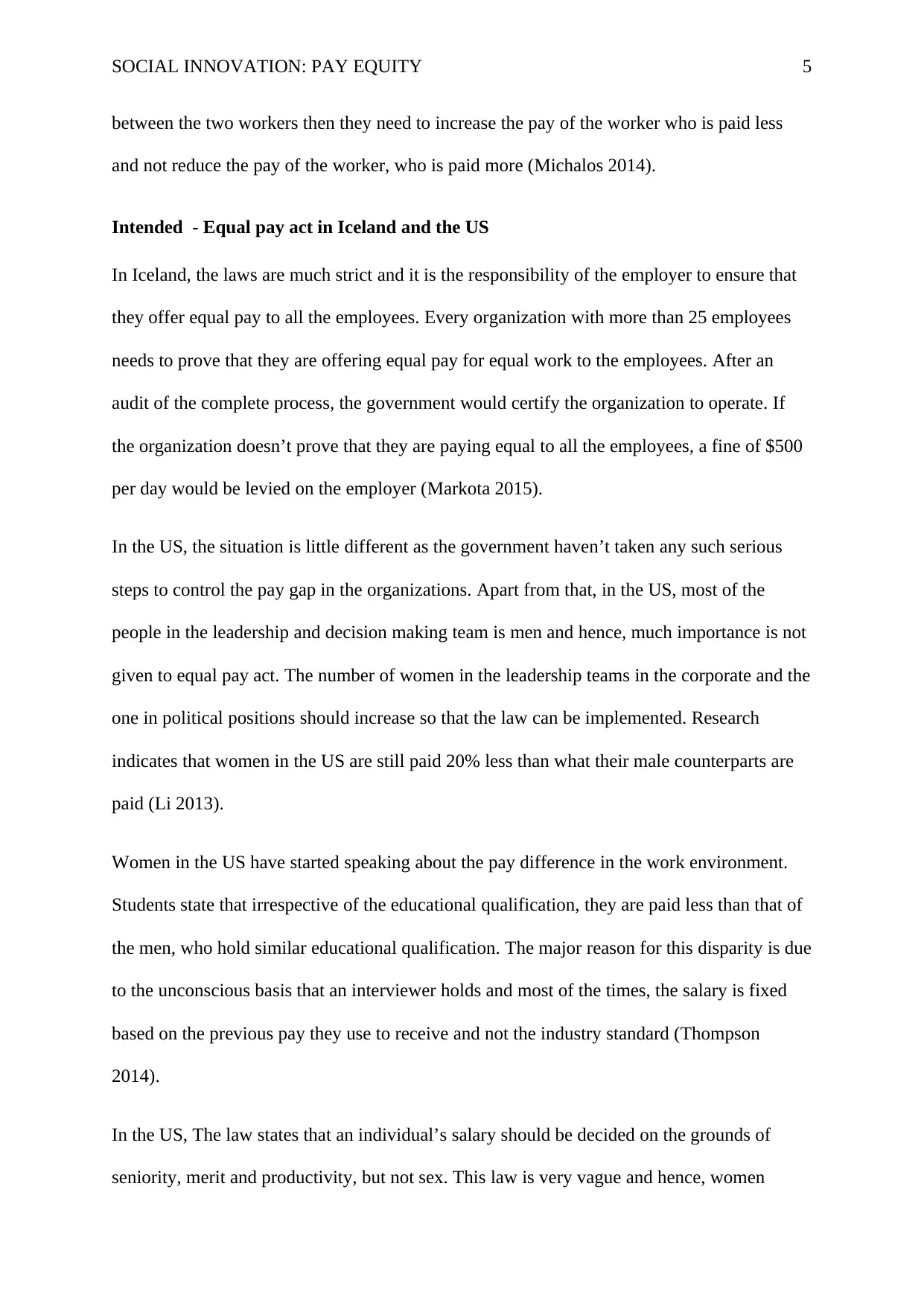
SOCIAL INNOVATION: PAY EQUITY 5
between the two workers then they need to increase the pay of the worker who is paid less
and not reduce the pay of the worker, who is paid more (Michalos 2014).
Intended - Equal pay act in Iceland and the US
In Iceland, the laws are much strict and it is the responsibility of the employer to ensure that
they offer equal pay to all the employees. Every organization with more than 25 employees
needs to prove that they are offering equal pay for equal work to the employees. After an
audit of the complete process, the government would certify the organization to operate. If
the organization doesn’t prove that they are paying equal to all the employees, a fine of $500
per day would be levied on the employer (Markota 2015).
In the US, the situation is little different as the government haven’t taken any such serious
steps to control the pay gap in the organizations. Apart from that, in the US, most of the
people in the leadership and decision making team is men and hence, much importance is not
given to equal pay act. The number of women in the leadership teams in the corporate and the
one in political positions should increase so that the law can be implemented. Research
indicates that women in the US are still paid 20% less than what their male counterparts are
paid (Li 2013).
Women in the US have started speaking about the pay difference in the work environment.
Students state that irrespective of the educational qualification, they are paid less than that of
the men, who hold similar educational qualification. The major reason for this disparity is due
to the unconscious basis that an interviewer holds and most of the times, the salary is fixed
based on the previous pay they use to receive and not the industry standard (Thompson
2014).
In the US, The law states that an individual’s salary should be decided on the grounds of
seniority, merit and productivity, but not sex. This law is very vague and hence, women
between the two workers then they need to increase the pay of the worker who is paid less
and not reduce the pay of the worker, who is paid more (Michalos 2014).
Intended - Equal pay act in Iceland and the US
In Iceland, the laws are much strict and it is the responsibility of the employer to ensure that
they offer equal pay to all the employees. Every organization with more than 25 employees
needs to prove that they are offering equal pay for equal work to the employees. After an
audit of the complete process, the government would certify the organization to operate. If
the organization doesn’t prove that they are paying equal to all the employees, a fine of $500
per day would be levied on the employer (Markota 2015).
In the US, the situation is little different as the government haven’t taken any such serious
steps to control the pay gap in the organizations. Apart from that, in the US, most of the
people in the leadership and decision making team is men and hence, much importance is not
given to equal pay act. The number of women in the leadership teams in the corporate and the
one in political positions should increase so that the law can be implemented. Research
indicates that women in the US are still paid 20% less than what their male counterparts are
paid (Li 2013).
Women in the US have started speaking about the pay difference in the work environment.
Students state that irrespective of the educational qualification, they are paid less than that of
the men, who hold similar educational qualification. The major reason for this disparity is due
to the unconscious basis that an interviewer holds and most of the times, the salary is fixed
based on the previous pay they use to receive and not the industry standard (Thompson
2014).
In the US, The law states that an individual’s salary should be decided on the grounds of
seniority, merit and productivity, but not sex. This law is very vague and hence, women
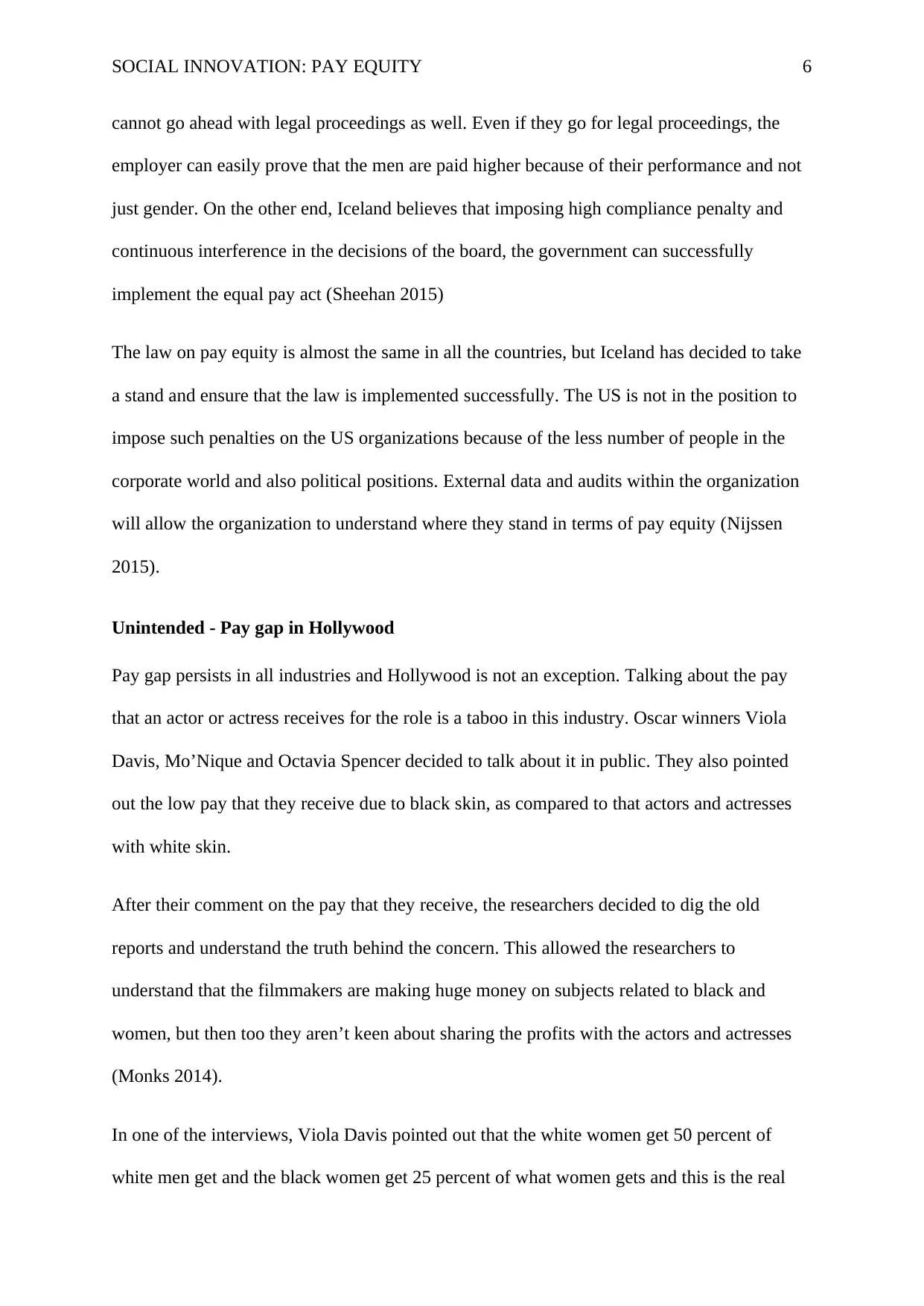
SOCIAL INNOVATION: PAY EQUITY 6
cannot go ahead with legal proceedings as well. Even if they go for legal proceedings, the
employer can easily prove that the men are paid higher because of their performance and not
just gender. On the other end, Iceland believes that imposing high compliance penalty and
continuous interference in the decisions of the board, the government can successfully
implement the equal pay act (Sheehan 2015)
The law on pay equity is almost the same in all the countries, but Iceland has decided to take
a stand and ensure that the law is implemented successfully. The US is not in the position to
impose such penalties on the US organizations because of the less number of people in the
corporate world and also political positions. External data and audits within the organization
will allow the organization to understand where they stand in terms of pay equity (Nijssen
2015).
Unintended - Pay gap in Hollywood
Pay gap persists in all industries and Hollywood is not an exception. Talking about the pay
that an actor or actress receives for the role is a taboo in this industry. Oscar winners Viola
Davis, Mo’Nique and Octavia Spencer decided to talk about it in public. They also pointed
out the low pay that they receive due to black skin, as compared to that actors and actresses
with white skin.
After their comment on the pay that they receive, the researchers decided to dig the old
reports and understand the truth behind the concern. This allowed the researchers to
understand that the filmmakers are making huge money on subjects related to black and
women, but then too they aren’t keen about sharing the profits with the actors and actresses
(Monks 2014).
In one of the interviews, Viola Davis pointed out that the white women get 50 percent of
white men get and the black women get 25 percent of what women gets and this is the real
cannot go ahead with legal proceedings as well. Even if they go for legal proceedings, the
employer can easily prove that the men are paid higher because of their performance and not
just gender. On the other end, Iceland believes that imposing high compliance penalty and
continuous interference in the decisions of the board, the government can successfully
implement the equal pay act (Sheehan 2015)
The law on pay equity is almost the same in all the countries, but Iceland has decided to take
a stand and ensure that the law is implemented successfully. The US is not in the position to
impose such penalties on the US organizations because of the less number of people in the
corporate world and also political positions. External data and audits within the organization
will allow the organization to understand where they stand in terms of pay equity (Nijssen
2015).
Unintended - Pay gap in Hollywood
Pay gap persists in all industries and Hollywood is not an exception. Talking about the pay
that an actor or actress receives for the role is a taboo in this industry. Oscar winners Viola
Davis, Mo’Nique and Octavia Spencer decided to talk about it in public. They also pointed
out the low pay that they receive due to black skin, as compared to that actors and actresses
with white skin.
After their comment on the pay that they receive, the researchers decided to dig the old
reports and understand the truth behind the concern. This allowed the researchers to
understand that the filmmakers are making huge money on subjects related to black and
women, but then too they aren’t keen about sharing the profits with the actors and actresses
(Monks 2014).
In one of the interviews, Viola Davis pointed out that the white women get 50 percent of
white men get and the black women get 25 percent of what women gets and this is the real
You're viewing a preview
Unlock full access by subscribing today!
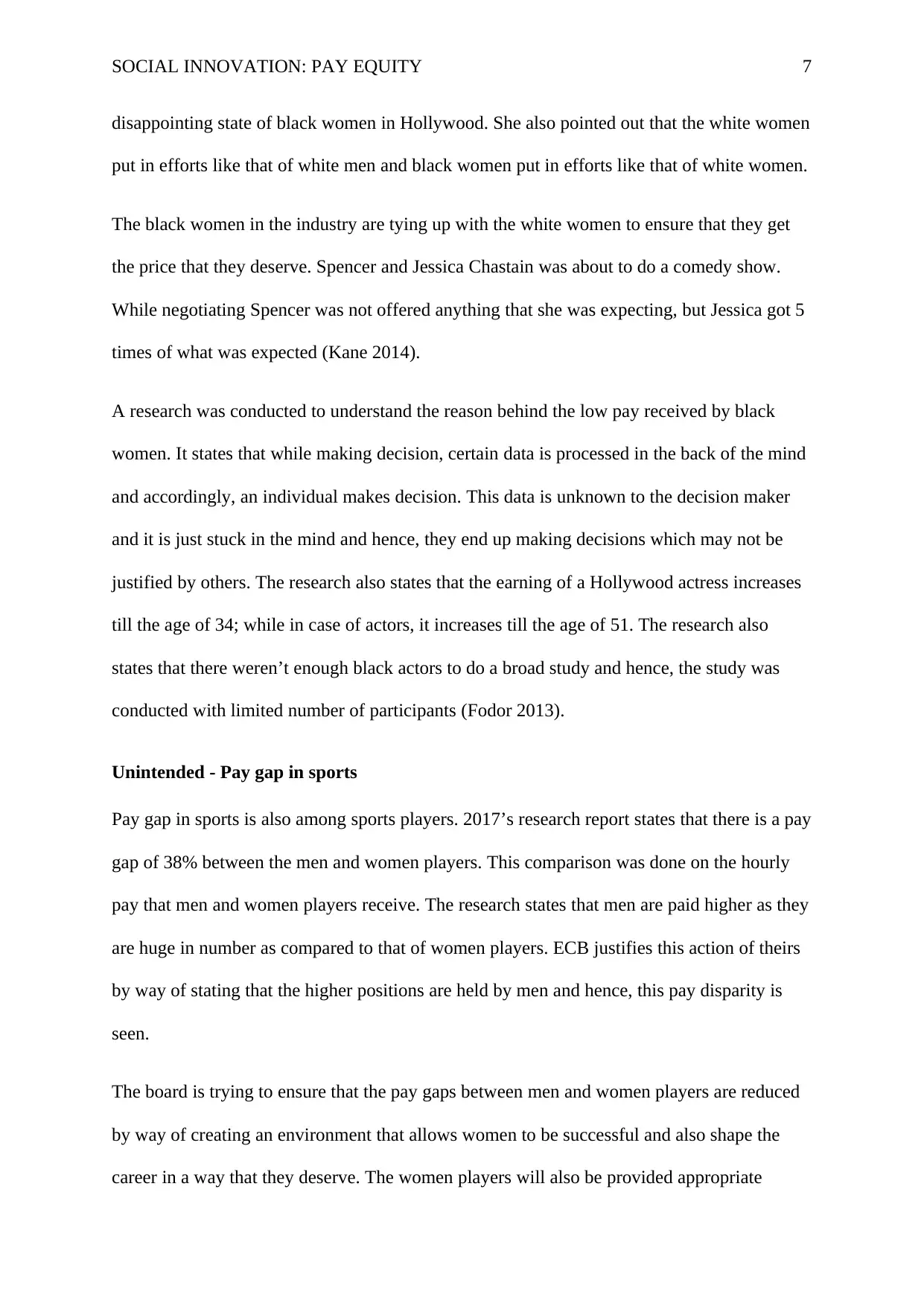
SOCIAL INNOVATION: PAY EQUITY 7
disappointing state of black women in Hollywood. She also pointed out that the white women
put in efforts like that of white men and black women put in efforts like that of white women.
The black women in the industry are tying up with the white women to ensure that they get
the price that they deserve. Spencer and Jessica Chastain was about to do a comedy show.
While negotiating Spencer was not offered anything that she was expecting, but Jessica got 5
times of what was expected (Kane 2014).
A research was conducted to understand the reason behind the low pay received by black
women. It states that while making decision, certain data is processed in the back of the mind
and accordingly, an individual makes decision. This data is unknown to the decision maker
and it is just stuck in the mind and hence, they end up making decisions which may not be
justified by others. The research also states that the earning of a Hollywood actress increases
till the age of 34; while in case of actors, it increases till the age of 51. The research also
states that there weren’t enough black actors to do a broad study and hence, the study was
conducted with limited number of participants (Fodor 2013).
Unintended - Pay gap in sports
Pay gap in sports is also among sports players. 2017’s research report states that there is a pay
gap of 38% between the men and women players. This comparison was done on the hourly
pay that men and women players receive. The research states that men are paid higher as they
are huge in number as compared to that of women players. ECB justifies this action of theirs
by way of stating that the higher positions are held by men and hence, this pay disparity is
seen.
The board is trying to ensure that the pay gaps between men and women players are reduced
by way of creating an environment that allows women to be successful and also shape the
career in a way that they deserve. The women players will also be provided appropriate
disappointing state of black women in Hollywood. She also pointed out that the white women
put in efforts like that of white men and black women put in efforts like that of white women.
The black women in the industry are tying up with the white women to ensure that they get
the price that they deserve. Spencer and Jessica Chastain was about to do a comedy show.
While negotiating Spencer was not offered anything that she was expecting, but Jessica got 5
times of what was expected (Kane 2014).
A research was conducted to understand the reason behind the low pay received by black
women. It states that while making decision, certain data is processed in the back of the mind
and accordingly, an individual makes decision. This data is unknown to the decision maker
and it is just stuck in the mind and hence, they end up making decisions which may not be
justified by others. The research also states that the earning of a Hollywood actress increases
till the age of 34; while in case of actors, it increases till the age of 51. The research also
states that there weren’t enough black actors to do a broad study and hence, the study was
conducted with limited number of participants (Fodor 2013).
Unintended - Pay gap in sports
Pay gap in sports is also among sports players. 2017’s research report states that there is a pay
gap of 38% between the men and women players. This comparison was done on the hourly
pay that men and women players receive. The research states that men are paid higher as they
are huge in number as compared to that of women players. ECB justifies this action of theirs
by way of stating that the higher positions are held by men and hence, this pay disparity is
seen.
The board is trying to ensure that the pay gaps between men and women players are reduced
by way of creating an environment that allows women to be successful and also shape the
career in a way that they deserve. The women players will also be provided appropriate
Paraphrase This Document
Need a fresh take? Get an instant paraphrase of this document with our AI Paraphraser
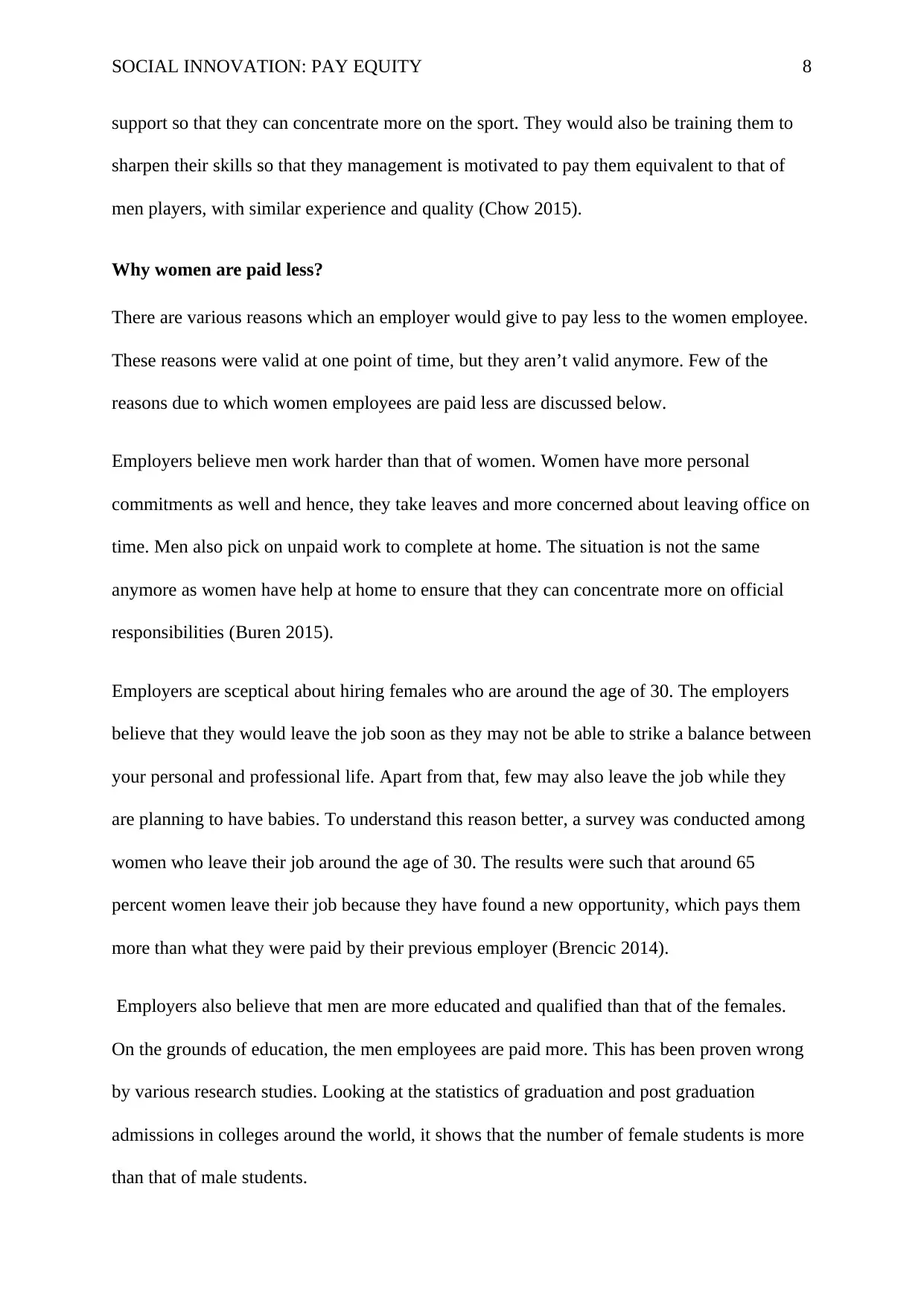
SOCIAL INNOVATION: PAY EQUITY 8
support so that they can concentrate more on the sport. They would also be training them to
sharpen their skills so that they management is motivated to pay them equivalent to that of
men players, with similar experience and quality (Chow 2015).
Why women are paid less?
There are various reasons which an employer would give to pay less to the women employee.
These reasons were valid at one point of time, but they aren’t valid anymore. Few of the
reasons due to which women employees are paid less are discussed below.
Employers believe men work harder than that of women. Women have more personal
commitments as well and hence, they take leaves and more concerned about leaving office on
time. Men also pick on unpaid work to complete at home. The situation is not the same
anymore as women have help at home to ensure that they can concentrate more on official
responsibilities (Buren 2015).
Employers are sceptical about hiring females who are around the age of 30. The employers
believe that they would leave the job soon as they may not be able to strike a balance between
your personal and professional life. Apart from that, few may also leave the job while they
are planning to have babies. To understand this reason better, a survey was conducted among
women who leave their job around the age of 30. The results were such that around 65
percent women leave their job because they have found a new opportunity, which pays them
more than what they were paid by their previous employer (Brencic 2014).
Employers also believe that men are more educated and qualified than that of the females.
On the grounds of education, the men employees are paid more. This has been proven wrong
by various research studies. Looking at the statistics of graduation and post graduation
admissions in colleges around the world, it shows that the number of female students is more
than that of male students.
support so that they can concentrate more on the sport. They would also be training them to
sharpen their skills so that they management is motivated to pay them equivalent to that of
men players, with similar experience and quality (Chow 2015).
Why women are paid less?
There are various reasons which an employer would give to pay less to the women employee.
These reasons were valid at one point of time, but they aren’t valid anymore. Few of the
reasons due to which women employees are paid less are discussed below.
Employers believe men work harder than that of women. Women have more personal
commitments as well and hence, they take leaves and more concerned about leaving office on
time. Men also pick on unpaid work to complete at home. The situation is not the same
anymore as women have help at home to ensure that they can concentrate more on official
responsibilities (Buren 2015).
Employers are sceptical about hiring females who are around the age of 30. The employers
believe that they would leave the job soon as they may not be able to strike a balance between
your personal and professional life. Apart from that, few may also leave the job while they
are planning to have babies. To understand this reason better, a survey was conducted among
women who leave their job around the age of 30. The results were such that around 65
percent women leave their job because they have found a new opportunity, which pays them
more than what they were paid by their previous employer (Brencic 2014).
Employers also believe that men are more educated and qualified than that of the females.
On the grounds of education, the men employees are paid more. This has been proven wrong
by various research studies. Looking at the statistics of graduation and post graduation
admissions in colleges around the world, it shows that the number of female students is more
than that of male students.
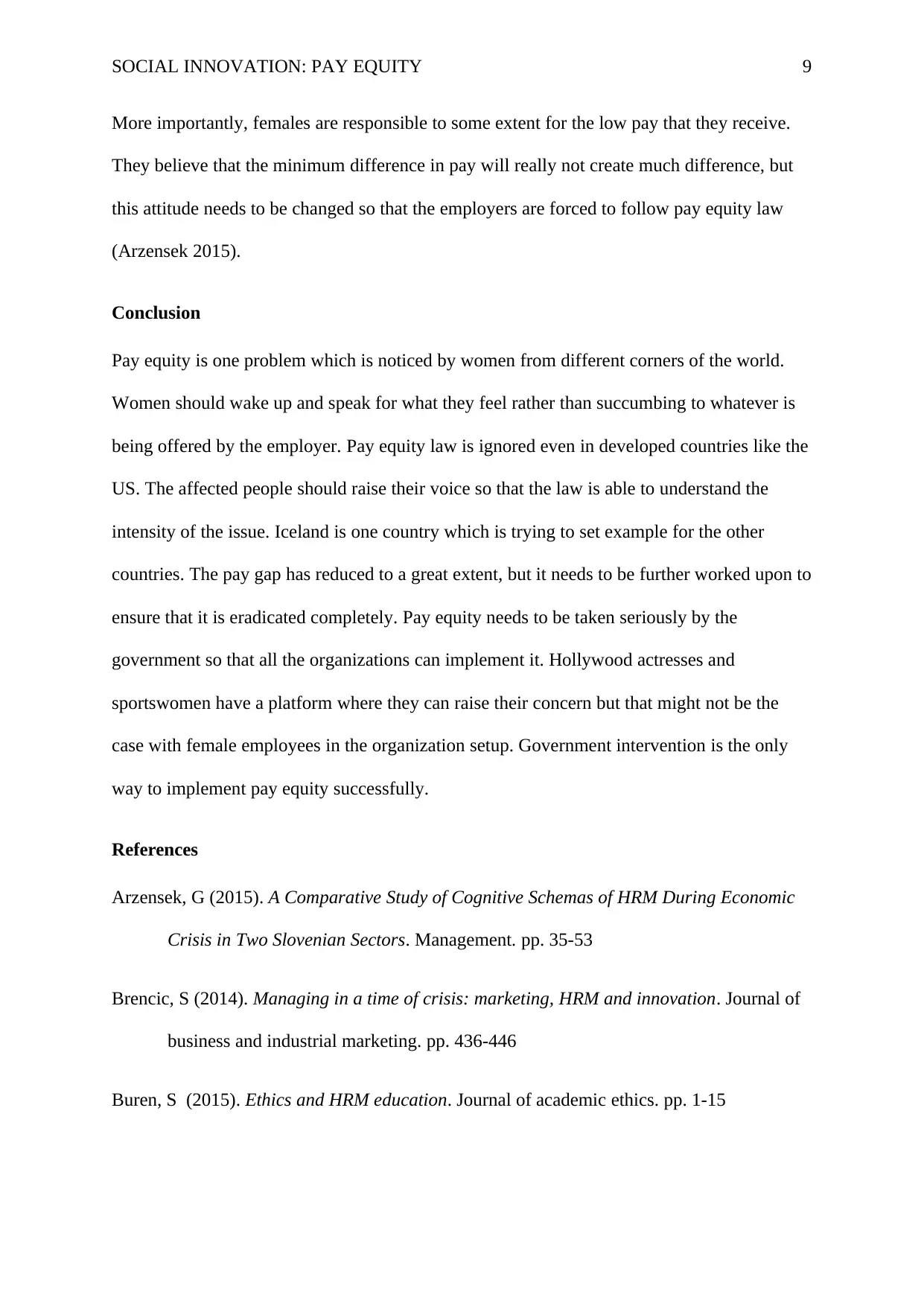
SOCIAL INNOVATION: PAY EQUITY 9
More importantly, females are responsible to some extent for the low pay that they receive.
They believe that the minimum difference in pay will really not create much difference, but
this attitude needs to be changed so that the employers are forced to follow pay equity law
(Arzensek 2015).
Conclusion
Pay equity is one problem which is noticed by women from different corners of the world.
Women should wake up and speak for what they feel rather than succumbing to whatever is
being offered by the employer. Pay equity law is ignored even in developed countries like the
US. The affected people should raise their voice so that the law is able to understand the
intensity of the issue. Iceland is one country which is trying to set example for the other
countries. The pay gap has reduced to a great extent, but it needs to be further worked upon to
ensure that it is eradicated completely. Pay equity needs to be taken seriously by the
government so that all the organizations can implement it. Hollywood actresses and
sportswomen have a platform where they can raise their concern but that might not be the
case with female employees in the organization setup. Government intervention is the only
way to implement pay equity successfully.
References
Arzensek, G (2015). A Comparative Study of Cognitive Schemas of HRM During Economic
Crisis in Two Slovenian Sectors. Management. pp. 35-53
Brencic, S (2014). Managing in a time of crisis: marketing, HRM and innovation. Journal of
business and industrial marketing. pp. 436-446
Buren, S (2015). Ethics and HRM education. Journal of academic ethics. pp. 1-15
More importantly, females are responsible to some extent for the low pay that they receive.
They believe that the minimum difference in pay will really not create much difference, but
this attitude needs to be changed so that the employers are forced to follow pay equity law
(Arzensek 2015).
Conclusion
Pay equity is one problem which is noticed by women from different corners of the world.
Women should wake up and speak for what they feel rather than succumbing to whatever is
being offered by the employer. Pay equity law is ignored even in developed countries like the
US. The affected people should raise their voice so that the law is able to understand the
intensity of the issue. Iceland is one country which is trying to set example for the other
countries. The pay gap has reduced to a great extent, but it needs to be further worked upon to
ensure that it is eradicated completely. Pay equity needs to be taken seriously by the
government so that all the organizations can implement it. Hollywood actresses and
sportswomen have a platform where they can raise their concern but that might not be the
case with female employees in the organization setup. Government intervention is the only
way to implement pay equity successfully.
References
Arzensek, G (2015). A Comparative Study of Cognitive Schemas of HRM During Economic
Crisis in Two Slovenian Sectors. Management. pp. 35-53
Brencic, S (2014). Managing in a time of crisis: marketing, HRM and innovation. Journal of
business and industrial marketing. pp. 436-446
Buren, S (2015). Ethics and HRM education. Journal of academic ethics. pp. 1-15
You're viewing a preview
Unlock full access by subscribing today!
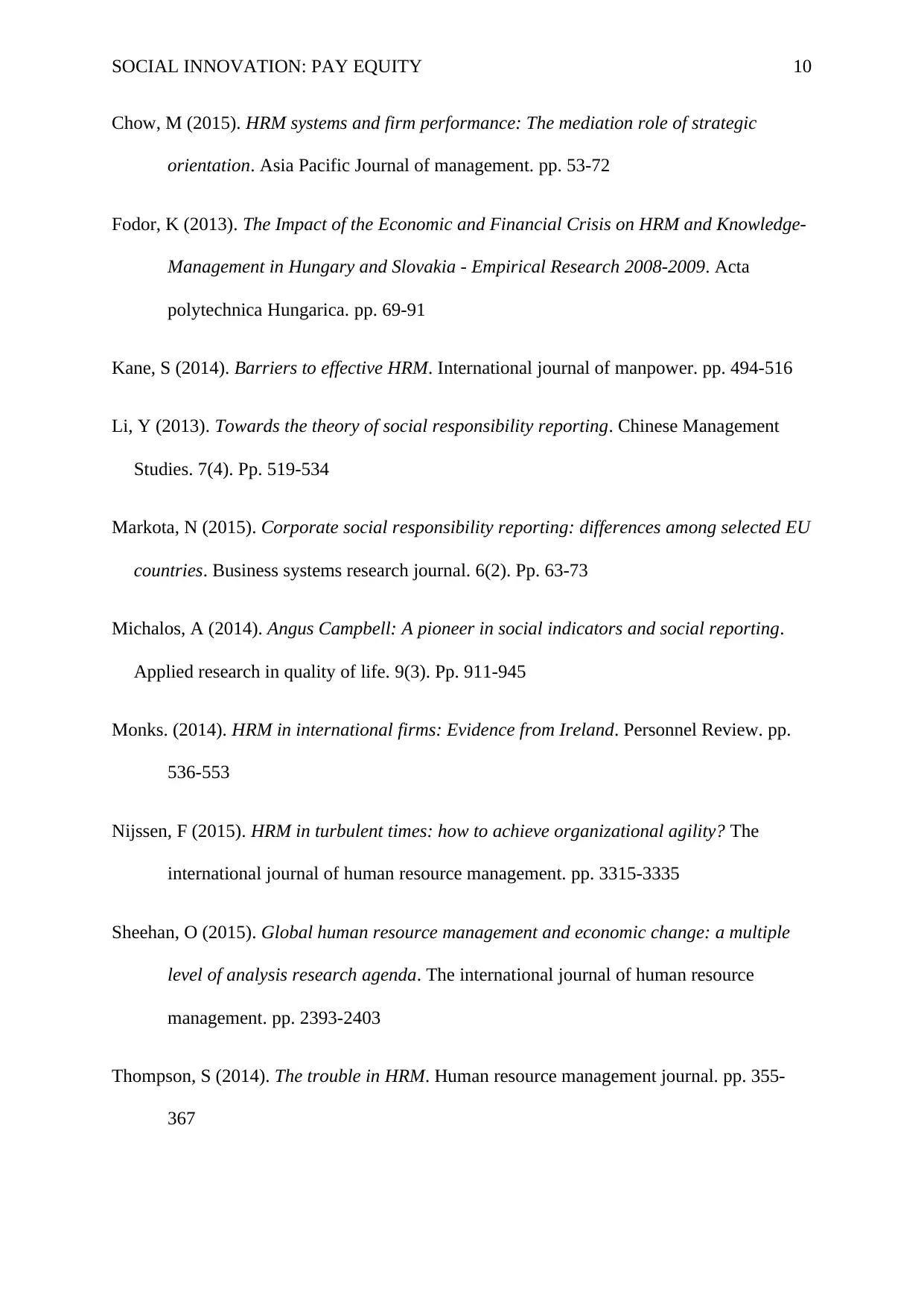
SOCIAL INNOVATION: PAY EQUITY 10
Chow, M (2015). HRM systems and firm performance: The mediation role of strategic
orientation. Asia Pacific Journal of management. pp. 53-72
Fodor, K (2013). The Impact of the Economic and Financial Crisis on HRM and Knowledge-
Management in Hungary and Slovakia - Empirical Research 2008-2009. Acta
polytechnica Hungarica. pp. 69-91
Kane, S (2014). Barriers to effective HRM. International journal of manpower. pp. 494-516
Li, Y (2013). Towards the theory of social responsibility reporting. Chinese Management
Studies. 7(4). Pp. 519-534
Markota, N (2015). Corporate social responsibility reporting: differences among selected EU
countries. Business systems research journal. 6(2). Pp. 63-73
Michalos, A (2014). Angus Campbell: A pioneer in social indicators and social reporting.
Applied research in quality of life. 9(3). Pp. 911-945
Monks. (2014). HRM in international firms: Evidence from Ireland. Personnel Review. pp.
536-553
Nijssen, F (2015). HRM in turbulent times: how to achieve organizational agility? The
international journal of human resource management. pp. 3315-3335
Sheehan, O (2015). Global human resource management and economic change: a multiple
level of analysis research agenda. The international journal of human resource
management. pp. 2393-2403
Thompson, S (2014). The trouble in HRM. Human resource management journal. pp. 355-
367
Chow, M (2015). HRM systems and firm performance: The mediation role of strategic
orientation. Asia Pacific Journal of management. pp. 53-72
Fodor, K (2013). The Impact of the Economic and Financial Crisis on HRM and Knowledge-
Management in Hungary and Slovakia - Empirical Research 2008-2009. Acta
polytechnica Hungarica. pp. 69-91
Kane, S (2014). Barriers to effective HRM. International journal of manpower. pp. 494-516
Li, Y (2013). Towards the theory of social responsibility reporting. Chinese Management
Studies. 7(4). Pp. 519-534
Markota, N (2015). Corporate social responsibility reporting: differences among selected EU
countries. Business systems research journal. 6(2). Pp. 63-73
Michalos, A (2014). Angus Campbell: A pioneer in social indicators and social reporting.
Applied research in quality of life. 9(3). Pp. 911-945
Monks. (2014). HRM in international firms: Evidence from Ireland. Personnel Review. pp.
536-553
Nijssen, F (2015). HRM in turbulent times: how to achieve organizational agility? The
international journal of human resource management. pp. 3315-3335
Sheehan, O (2015). Global human resource management and economic change: a multiple
level of analysis research agenda. The international journal of human resource
management. pp. 2393-2403
Thompson, S (2014). The trouble in HRM. Human resource management journal. pp. 355-
367
Paraphrase This Document
Need a fresh take? Get an instant paraphrase of this document with our AI Paraphraser
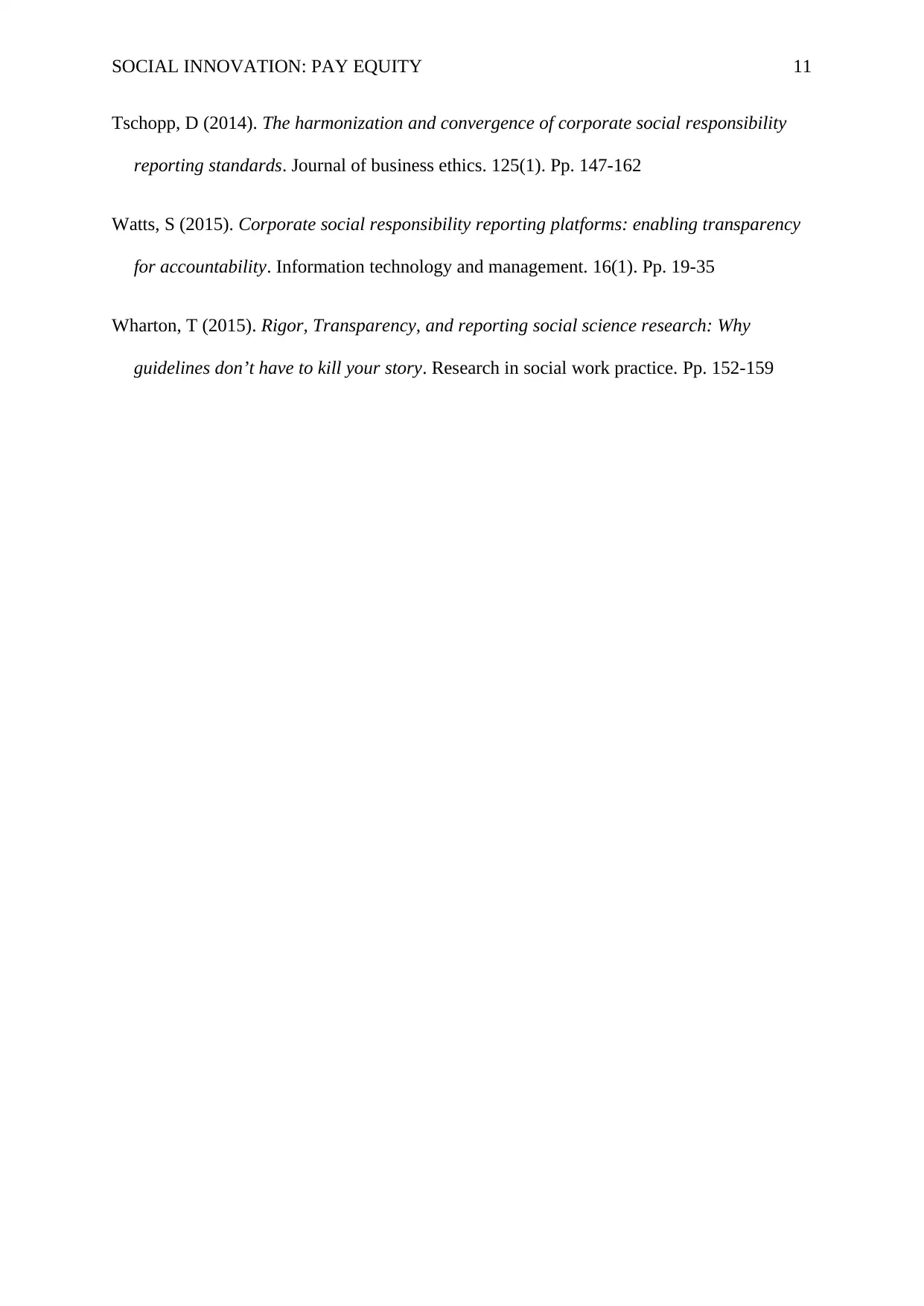
SOCIAL INNOVATION: PAY EQUITY 11
Tschopp, D (2014). The harmonization and convergence of corporate social responsibility
reporting standards. Journal of business ethics. 125(1). Pp. 147-162
Watts, S (2015). Corporate social responsibility reporting platforms: enabling transparency
for accountability. Information technology and management. 16(1). Pp. 19-35
Wharton, T (2015). Rigor, Transparency, and reporting social science research: Why
guidelines don’t have to kill your story. Research in social work practice. Pp. 152-159
Tschopp, D (2014). The harmonization and convergence of corporate social responsibility
reporting standards. Journal of business ethics. 125(1). Pp. 147-162
Watts, S (2015). Corporate social responsibility reporting platforms: enabling transparency
for accountability. Information technology and management. 16(1). Pp. 19-35
Wharton, T (2015). Rigor, Transparency, and reporting social science research: Why
guidelines don’t have to kill your story. Research in social work practice. Pp. 152-159
1 out of 11
Related Documents
Your All-in-One AI-Powered Toolkit for Academic Success.
+13062052269
info@desklib.com
Available 24*7 on WhatsApp / Email
![[object Object]](/_next/static/media/star-bottom.7253800d.svg)
Unlock your academic potential
© 2024 | Zucol Services PVT LTD | All rights reserved.





